WhatsApp OTP: How to Send OTPs on WhatsApp?
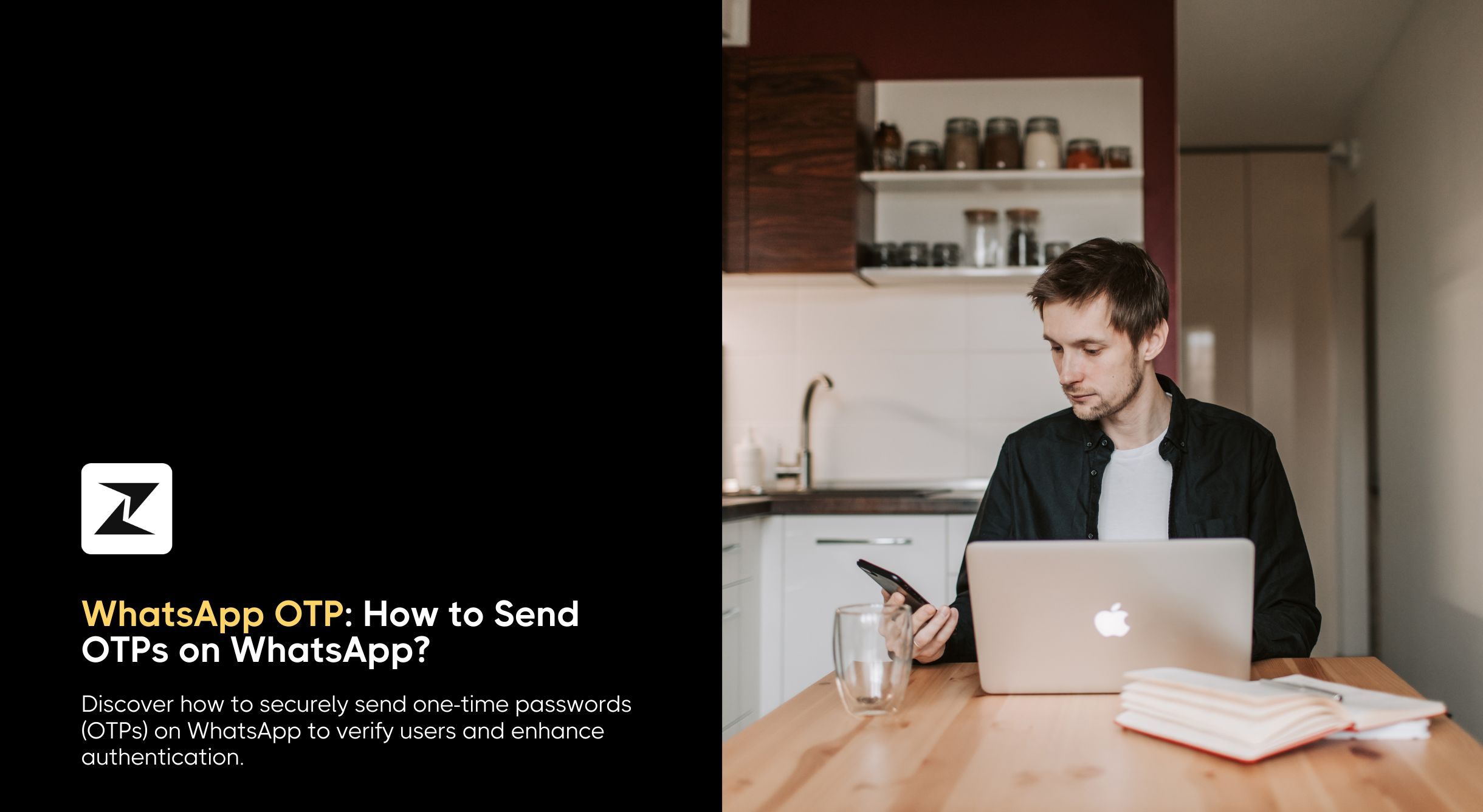
Suppose you placed an order online and were ready to receive its delivery, but couldn’t actually complete the process because you didn’t get an OTP. This can lead to an awkward and frustrating situation where you are left waiting for it while making small talk with the delivery person.
Another situation where timely delivery of OTPs is crucial is when a customer is signing up for your platform. An OTP message allows you to verify the authenticity of your customer’s details and get them started with your solutions.
Even today, companies are using SMS to send OTP messages because they are cost-effective and easy to send. However, the issue with these OTPs is that they rely on cellular network operators and can sometimes be undelivered when requested. Plus, the security on SMS OTPs is not as robust as you might believe.
For these reasons, businesses are looking for other channels to send these OTPs. WhatsApp has emerged as a great alternative to send prompt OTPs. Because of its security features and end-to-end encryption, WhatsApp OTPs are more secure than traditional channels.
That being said, in this blog post, I will go over the advantages of using WhatsApp OTP and how you can set it up for your business. So, let’s jump into it!
What is a WhatsApp OTP?
The concept of OTP is not a new one. If you’re running a business or involved in marketing, then you would already be aware of OTPs. WhatsApp OTP is a 6-digit code that is automatically captured by the apps to complete the signup process.
If the automated capture is not supported, you can copy the code by tapping the “copy” button and paste it effortlessly into the right place. Additionally, since WhatsApp messages are delivered using the internet, you don’t have to worry about being out of network service.
What are the benefits of using WhatsApp OTP?
Till now, SMS and emails have been the prominent channels for sending OTP messages. But WhatsApp is a more modern communication app with improved security and high delivery without increasing your messaging cost.
Here are some of the advantages of using WhatsApp for sending OTPs:
Enhanced delivery
In comparison to SMS, which depends on complex mobile networks and operators or emails that have a high chance of ending up as spam, WhatsApp OPTs are delivered successfully to the inbox of your target audience. Also, as I said before, WhatsApp messages are sent via the Internet or mobile data, you can receive them in remote areas with unstable mobile connectivity.
Secured compared to traditional channels
WhatsApp OTP messages are protected with end-to-end encryption. Unlike SMS or emails, which can be infiltrated by external third-parties or are prone to phishing attempts, WhatsApp OTPs are safe from outside threats.
Enhanced customer experience
WhatsApp OTPs lower the wait time as these messages are delivered in real time. Also, the automatic fill feature of WhatsApp makes it so that you don’t have to type it manually to finish the authentication process. Most apps that support WhatsApp OTPs come with this feature for seamless onboarding.
A more cost-efficiently way to send OTPs
If you are running an international business, then sending SMS OTPs to various countries can become expensive. Although WhatsApp’s pricing also varies based on the country, it is still significantly cheaper than SMS, particularly in nations where messaging costs are high. The high deliverability of WhatsApp messages saves you the retrying costs of sending the same OTPs again.
Simplify OTP Delivery on WhatsApp.
Start sending lightning-fast OTPs using Zixflow’s WhatsApp Business API.
Book a DemoHow to set up WhatsApp OTPs for your business?
Now that you know what WhatsApp OTP is and the advantages it offers, it is time to look at the steps to incorporate it into your verification process. The easiest way to get started with sending WhatsApp OTPs is to use WhatsApp Business API. Below is a step-by-step process:
Set up your WhatsApp Business account
The first step of this process is to set up your WhatsApp Business account. The process involves adding your business’s details on Meta’s website and linking a mobile number you would like to use for sending these messages.
There are a couple of ways to create a WhatsApp Business account. First, you can visit the Meta for Developers and set it up yourself. If you decide to do that, you can follow our WhatsApp Business Cloud API guide to walk you through the entire process. However, the problem with this approach is that, since the API doesn’t have a front-end UI, you have to link it to a WhatsApp tool before you can start sending WhatsApp OTP messages.
So, rather than dividing this step into two separate processes, you can get the tool first and do the entire setup process in one go. For the sake of simplicity, I will tell you how to complete this process using Zixflow.
To begin with, create a Zixflow account and head to the WhatsApp section. Once here, click Settings in the top bar and click the add number button.
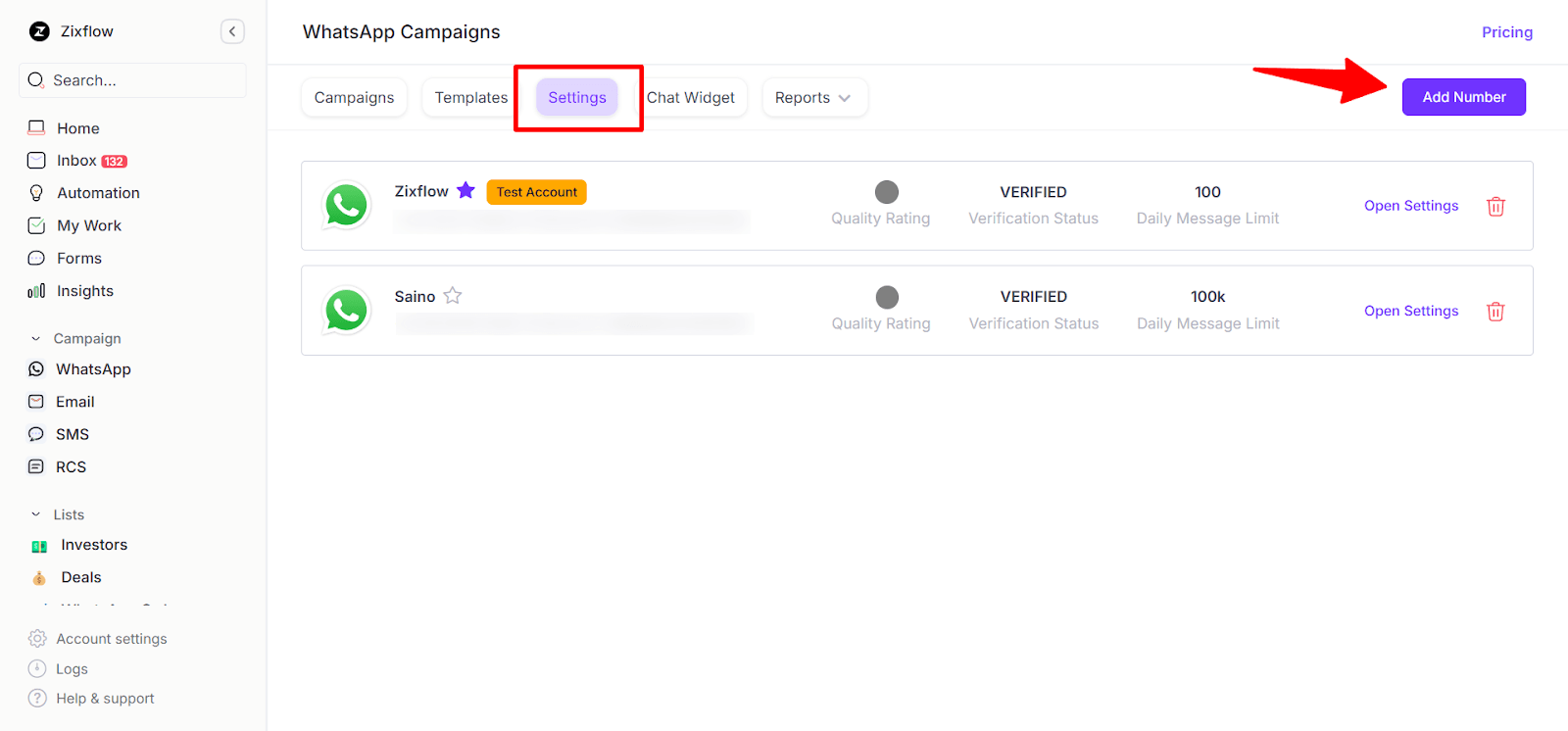
Read the integration guidelines and check the “I confirm that I am well aware of the above information.” box. After that, click the Continue with Facebook button to be redirected to the Facebook log in page to login to the Meta Business Manager.
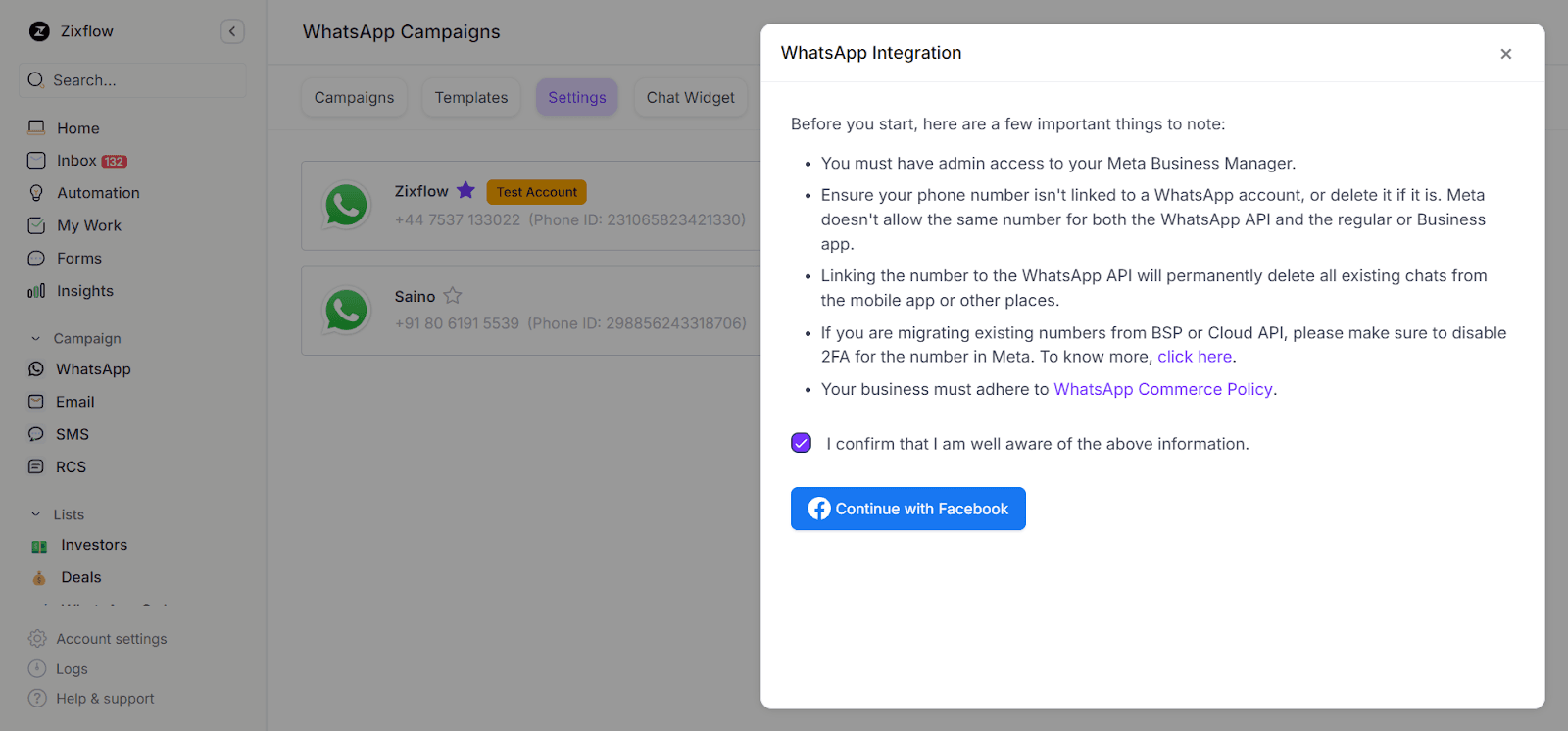
Once you are in the Meta Business Manager, create a WhatsApp app and fill in the basic business information. Following that, you have to link a phone number to your Meta Business Manager which will be used to send your WhatsApp OTPs.

Verify the number by entering the verification code. It might sound like too much work but it is a rather straightforward process. Here is a video guide to help you set up and integrate WhatsApp with Zixflow so you can send WhatsApp OTPs effectively:
Craft a messaging template and get it approved
After you have successfully connected Zixflow and WhatsApp, the next step is to create a WhatsApp Business messaging template for your OTP messages. It is WhatsApp’s policy that businesses can’t initiate a conversation with a WhatsApp user without a pre-approved messaging template, and OTPs are no exception.
Utilizing Zixflow’s template builder, you can craft a template by filling in the relevant information in the required fields. Navigate to the WhatsApp section and click the Template button. Click on the Add Template button and choose Authentication as the template type.
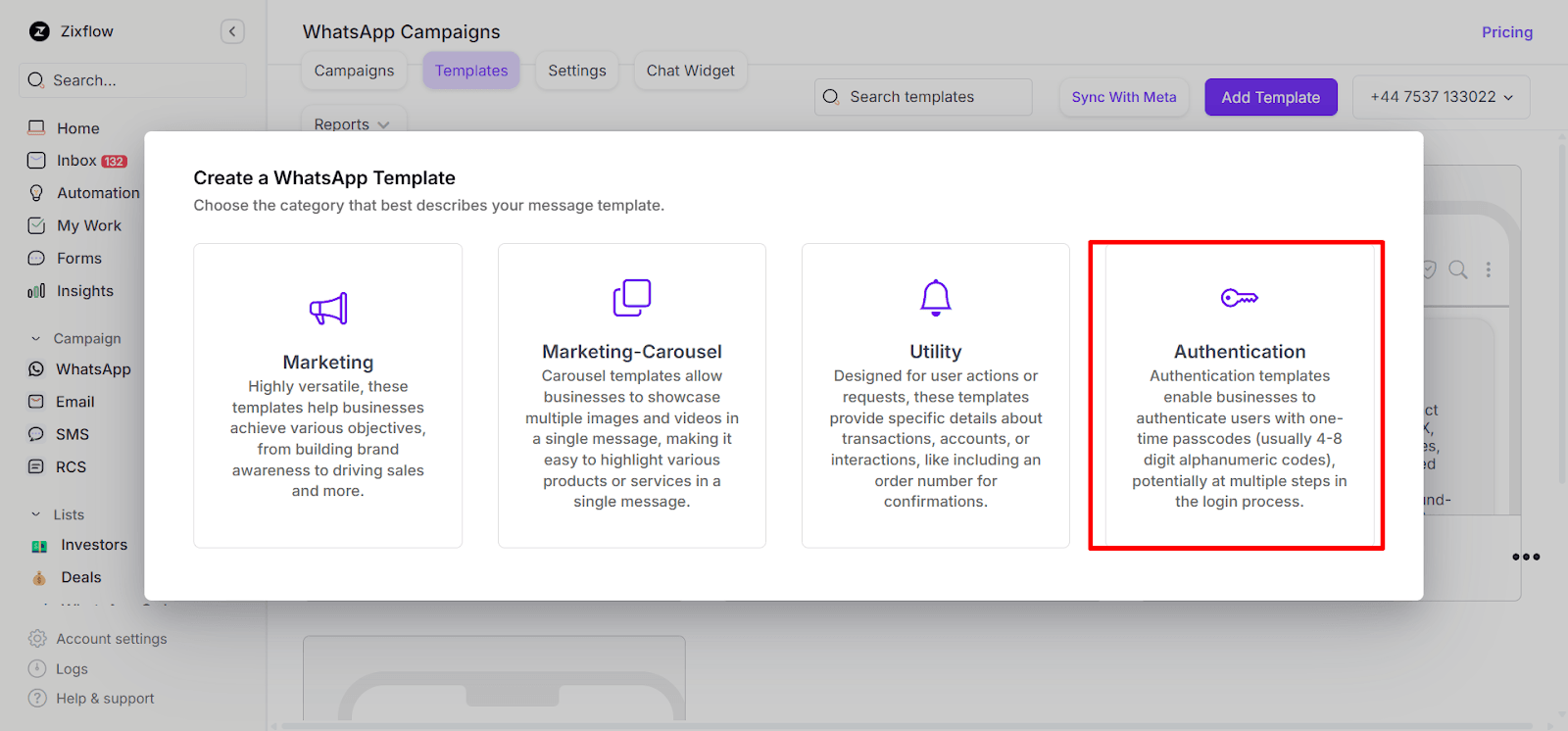
Because WhatsApp OTPs only contain the passcode for verification, you cannot add any other content to the message. Zixflow, however, allows you to customize how recipients can enter the received OTP. For example, you can choose between any of the following options:
- Copy code - Your customers copy and paste the code into your app.
- One-tap fill - The code will be filled in your app when recipients tap the Autofill button. A copy code message will be sent if auto-fill isn't possible.
- Zero-tap auto fill - Zero-tap will automatically send code without requiring your customer to tap a button. An auto-fill or copy code message will be sent if zero-tap is not possible.
You can add a security warning to your message and an expiry time for the code by checking the relevant boxes within the builder. You can also customize the text of the button.
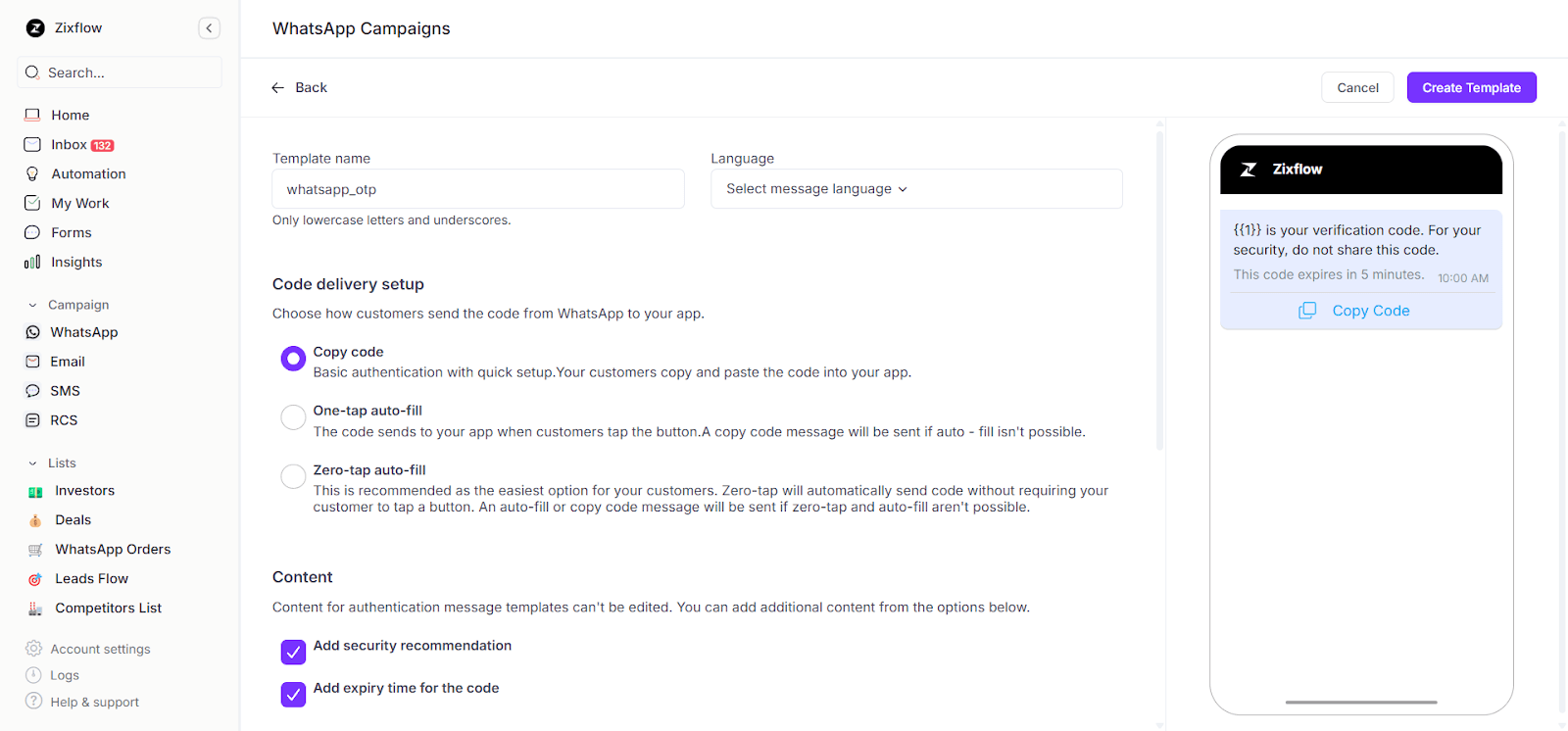
Once everything is done, click the Create Template button and your template will be saved in the system with the pending status. The template is ready for use after it gets approved by Meta.
Create an automated workflow for sending WhatsApp OTPs
Now you have an approved WhatsApp OTP template and a WhatsApp API provider that can send these messages to your customers when needed. The final step of this process is to set up an automation where this message will be delivered when requested by your users.
By leveraging Zixflow’s automated builder, you can define custom triggers for these messages to be sent. These triggers can be anything like, when a user signs up to your website, logs in to your app, or completes a purchase.
Below is a video explaining how to use Zixflow’s workflow editor and build an automated flow for sending WhatsApp OTP messages:
Boost OTP Success Rates with Zixflow.
Ditch unreliable SMS routes and use Zixflow to send reliable, trackable OTPs directly on WhatsApp to ensure fewer drop-offs during authentication.
Sign up For FreeSome of the common use cases of WhatsApp OTP
WhatsApp OTP authentication plays a key role in enhancing security and verifying users across various business scenarios. Below are several practical applications:
User sign up
You can use WhatsApp OTPs as part of two-factor authentication during account creation or log in. This method makes sure that only the rightful user can access the account. Since WhatsApp messages are typically opened quickly, this approach sees better engagement compared to email verification.
Package deliveries & accessing gated content
For delivery services, sending an OTP ensures that parcels are handed over to the correct recipient. Likewise, WhatsApp OTPs are used to control access to private events, premium communities, or other secure areas, ensuring that only verified individuals are granted entry.
Account recovery
When users forget their passwords, they can easily reset them using an OTP sent via WhatsApp. This simplifies and accelerates the recovery process, avoiding the longer steps usually involved in email-based methods where you are redirected to multiple pages of account recovery.
Payment confirmation
To safeguard financial transactions, you can send an OTP through WhatsApp before finalizing payments. This added step of verification helps prevent unauthorized access and fraud. High message open rates on WhatsApp mean users are more likely to respond quickly and confirm transactions in real-time.
Employee access
If you are an enterprise-grade business, you can use OTP verification to validate employees before granting system access to reinforce internal security. Customer service teams also leverage OTPs to authenticate users before addressing account-related queries, safeguarding sensitive customer details.
Booking appointments
Industries that depend on appointments such as healthcare providers, hairdressers, or service companies, often use WhatsApp OTPs to confirm bookings. This lowers the likelihood of no-shows by ensuring customers understand their scheduled times. In the same way, if you are a subscription-based platform, you can also use OTPs to verify new registrations, helping you keep your user base legitimate.
Streamline your business processes with timely WhatsApp OTPs
Utilizing WhatsApp for OTP verification is an excellent option for you if you are aiming to enhance user authentication with a secure and dependable method.
Compared to traditional email or SMS, WhatsApp offers end-to-end encryption and better message delivery rates. Whether it is for login validation, transaction approval, or scheduling appointments, WhatsApp ensures that access is granted only to the intended user quickly and efficiently.
To implement WhatsApp OTPs, you need to leverage the WhatsApp Business API, make use of approved templates, and follow WhatsApp’s opt-in guidelines.
Once everything is set up, you can deliver a seamless verification process that benefits both your users and you alike. WhatsApp Business partners like Zixflow allow you to manage your WhatsApp OTP messages from a single solution.
Get started with Zixflow using a 7-day free trial or talk to your team to help you set up your WhatsApp Business account effortlessly.
